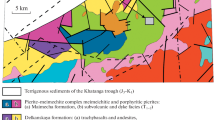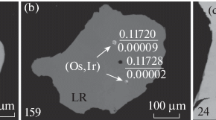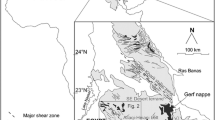Summary
¶Geological, mineralogical and Os isotopic data for detrital PGE-mineralization derived from the Guli and Bor-Uryah ultramafic massifs, within the Maimecha-Kotui Province (the northern part of the Siberian Platform, Russia), are presented for the first time. The detrital platinum-group minerals (PGM) are dominated by Os–Ir–(Ru) species, which is typical for ophiolites or Alpine-type complexes. However, the PGM assemblage in the placers investigated is similar to that derived from zoned platiniferous clinopyroxenite–dunite massifs (also known as Uralian-, Alaskan-type and Aldan-type massifs). The unique features of the Au-PGE placers at Guli are (1) the dominance of Os-rich alloys over other PGM and Au, and (2) the considerable predicted resources of noble metals, particularly osmium.
Dominant chromite, olivine and clinopyroxene inclusions recorded in Os–Ir–(Ru) alloys imply that they were derived from ultramafic sources (e.g., chromitite, dunite and clinopyroxenite). The first in situ osmium-isotope measurements by laser ablation - multiple collector - inductively coupled plasma mass spectrometry of different, intimately intergrown, PGM (e.g., laurite and Os-rich alloys) in various nuggets from Guli have revealed low 187Os/188Os and γOs values. They yield a very narrow range of 187Os/188Os (0.12432 to 0.12472) and γOs (− 2.39 to − 2.07). These values are indicative of a common chondritic or subchondritic mantle source of PGE. 187Os/188Os and γOs values of Os-rich alloys, derived from the Bor-Uryah massif, are different (i.e., γOs ranges from − 2.67 to − 1.30). The mineral-isotopic data obtained are consistent with the conclusion that the PGM were derived from parent ultramafic source rocks. Os-isotope model ages in the range of 495 to 240 Ma constrain the age of ultramafic protoliths in the northern part of the Siberian Craton. The variation in 187Os/188Os values for detrital PGM, where the provenance source is unknown, is considered to be a useful technique for distinguishing parent bedrock sources.
Similar content being viewed by others
Author information
Authors and Affiliations
Additional information
Received July 12, 2001; revised version accepted December 27, 2001
Rights and permissions
About this article
Cite this article
Malitch, K., Auge, T., Badanina, I. et al. Os-rich nuggets from Au-PGE placers of the Maimecha-Kotui Province, Russia: a multi-disciplinary study. Mineralogy and Petrology 76, 121–148 (2002). https://doi.org/10.1007/s007100200035
Issue Date:
DOI: https://doi.org/10.1007/s007100200035




